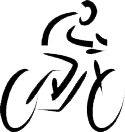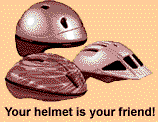Neuroscience For Kids
Deck the Halls with...Helmets?
by Ellen Kuwana, Neuroscience for Kids Staff Writer
December 4, 2009
 If a bicycle helmet is on your holiday wish list, you'll be happy to know
that more expensive helmets are not necessarily safer than the less
expensive helmets. An impact study by the Bicycle Helmet Safety Institute found
that $20 helmets performed about the same as $150 helmets.
If a bicycle helmet is on your holiday wish list, you'll be happy to know
that more expensive helmets are not necessarily safer than the less
expensive helmets. An impact study by the Bicycle Helmet Safety Institute found
that $20 helmets performed about the same as $150 helmets.
According to the Bicycle Helmet Safety Institute, in order to work properly and protect your head, a helmet — regardless of its price — must be fit correctly to your head. As everyone's head is different, the wearer must adjust the helmet to fit low and snug on the head. Helmets should fit as low as possible on the head, so remove any thick padding from the top inside, and use the thinnest pad there or none at all. The sides can be padded so that the fit is snug without being too tight. The helmet should be level and the front edge should be just above your eyebrows (or a bit above the frames of eye glasses). When you look up, you should just be able to see the helmet's rim.
 The straps should be adjusted so that the Y formed by the
two straps fits just under your ear. The chin strap should be tight enough
that when you open your mouth, you feel the helmet pull down slightly.
Adjust the Y straps first, then the chin strap. Many bicycle shops and
non-profit safety organizations will help you get a proper fit. This can
take up to 20 minutes, so be patient. The way to test if a helmet has a
good fit is to pretend to walk into a wall--the helmet's
front edge should hit before your nose, and the helmet should not tip
back, which would expose your forehead to damage. If the helmet tips back,
the rear side straps need to be tightened.
The straps should be adjusted so that the Y formed by the
two straps fits just under your ear. The chin strap should be tight enough
that when you open your mouth, you feel the helmet pull down slightly.
Adjust the Y straps first, then the chin strap. Many bicycle shops and
non-profit safety organizations will help you get a proper fit. This can
take up to 20 minutes, so be patient. The way to test if a helmet has a
good fit is to pretend to walk into a wall--the helmet's
front edge should hit before your nose, and the helmet should not tip
back, which would expose your forehead to damage. If the helmet tips back,
the rear side straps need to be tightened.
 After fitting the helmet, shake your head gently. Then take your
hand and push back on the front of the helmet. If it slides back more
than an inch, exposing the forehead, the helmet needs to be adjusted again
for a better fit. Some straps lock in place with a plastic clip; others do
not. For the ones that do not lock in place, a rubber band can be wound
around the strap just below the adjustment slider in order to keep the
straps in place. Be sure to check the fit of the helmet each time you use
it.
After fitting the helmet, shake your head gently. Then take your
hand and push back on the front of the helmet. If it slides back more
than an inch, exposing the forehead, the helmet needs to be adjusted again
for a better fit. Some straps lock in place with a plastic clip; others do
not. For the ones that do not lock in place, a rubber band can be wound
around the strap just below the adjustment slider in order to keep the
straps in place. Be sure to check the fit of the helmet each time you use
it.
So, regardless of what you spend on a bicycle helmet for loved ones, your gift will protect their heads.
![]() Caution: do not let wear a bicycle helmet while climbing
trees or monkey bars! The helmet may get caught and its straps may be
wrapped around your neck.
Caution: do not let wear a bicycle helmet while climbing
trees or monkey bars! The helmet may get caught and its straps may be
wrapped around your neck.
References and more information:
Copyright © 1996-2009, Eric H. Chudler, University of Washington
